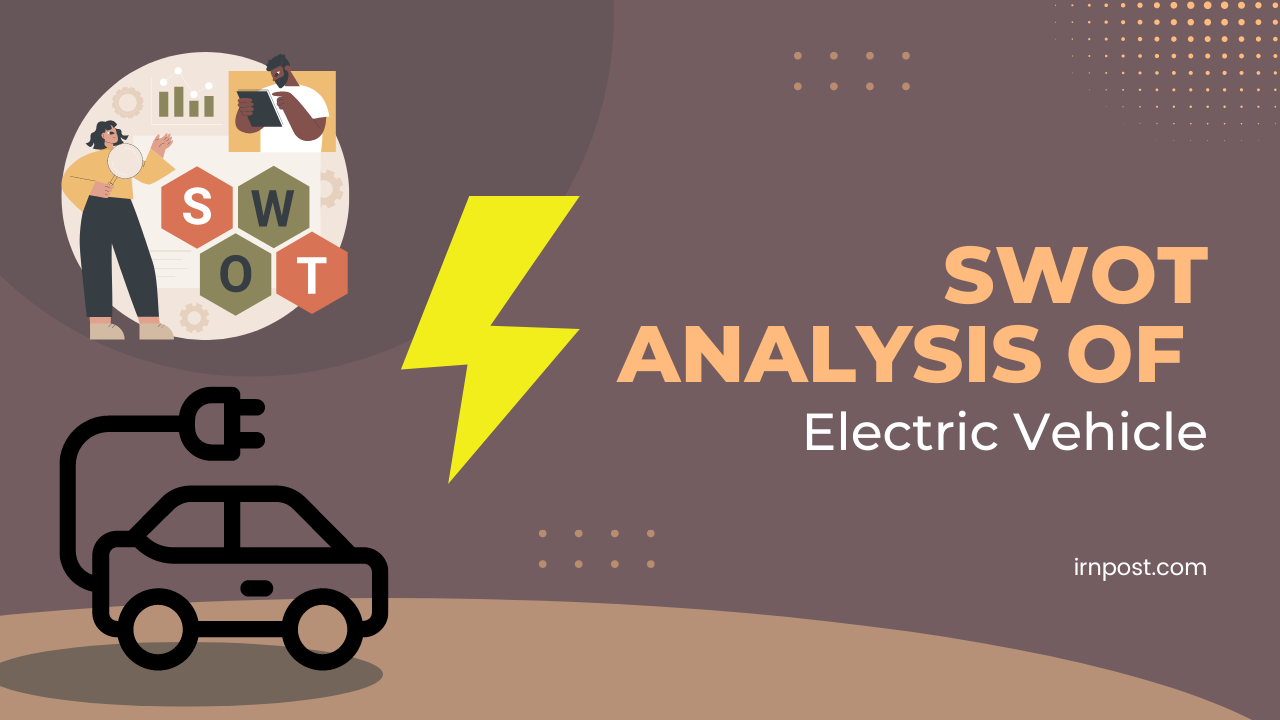Analysis
SWOT Analysis of Electric Vehicle

SWOT Analysis of electric vehicles is an analysis tool used to evaluate the Strengths, Weaknesses, Opportunities, and Threats (SWOT) associated with adopting and using electric vehicles. This analysis can help identify areas where improvements are needed or capitalize on existing strengths by looking at all aspects of the industry, from technology advancements to regulations.
Importance of SWOT Analysis For Electric Vehicles
Electric vehicles (EVs) have become increasingly popular in recent years as consumers look for alternative modes of transportation that are environmentally friendly and cost-effective. Using electric vehicles not only reduces greenhouse gas emissions but also helps to reduce dependence on fossil fuels.
Strengths
Eco-Friendly and Silent: One of the biggest advantages of electric vehicles is that they emit significantly lower levels of pollutants than traditional gasoline-powered vehicles. This makes EVs an eco-friendly option for people concerned about the environment and want to reduce their carbon footprint. Electric vehicles are much quieter than traditional cars, providing a more peaceful driving experience.
Low Cost of Ownership: The cost of ownership for electric vehicles is lower than that of traditional gasoline-powered vehicles. This is because electric vehicles require less maintenance and have a longer lifespan than gasoline-powered vehicles.
Cost of running an electric vehicle is lower than that of a gasoline-powered vehicle, as the cost of electricity is significantly lower than the cost of gasoline.
Cheaper to Run: Electric vehicles are cheaper to run than traditional gasoline-powered vehicles. The cost of electricity is significantly lower than the cost of gasoline, meaning that electric vehicle owners can save money on fuel costs.
Electric vehicles have regenerative braking systems that can help save energy, reducing the cost of running an electric vehicle.
Simpler Mechanism: The mechanism of an electric vehicle is much simpler than that of a traditional gasoline-powered vehicle. So, there are fewer moving parts, reducing the risk of mechanical failure and the need for repairs.
Opportunities
Government Subsidies for Ownership: Governments worldwide are providing subsidies for electric vehicle ownership to encourage the adoption of this environmentally friendly mode of transportation. This can make electric vehicles more affordable for consumers, helping to increase the popularity of EVs.
No Congestion Charge: In some cities, electric vehicles are exempt from congestion charges, saving owners a significant amount of money. This is an attractive feature for people who frequently drive in congested cities.
Lower Taxes: Electric vehicles are often subject to lower taxes than traditional gasoline-powered vehicles, making them more affordable for consumers.
Increasing Fossil Fuel Costs: The cost of fossil fuels is increasing, making gasoline-powered vehicles more expensive. Electric vehicles, on the other hand, are becoming more affordable as the cost of electricity remains relatively stable.
Weaknesses
Needs Time to Recharge: One of the biggest drawbacks of electric vehicles is their need to recharge. This can be a problem for people who need to travel long distances, as there is currently a limited network of charging stations.
Lack of Recharging Infrastructure: Although the number of charging stations is increasing, there is still a lack of recharging infrastructure in many parts of the world. This can make it difficult for electric vehicle owners to find a place to recharge their vehicles when they are on the road.
Batteries Change is Expensive: Replacing the batteries in an electric vehicle can be expensive, especially if the vehicle is out of warranty. This can be a high cost for electric vehicle owners.
Threats
Competition from Electric Hybrids, Alternative Fuels, and Hydrogen-Powered Cars: Electric vehicles face competition from other alternative fuel vehicles, such as electric hybrids and hydrogen-powered cars.
These vehicles offer similar benefits as electric vehicles, but they may be more attractive to consumers due to their longer driving range and more established refuelling infrastructure.
Rise in Cost of Electricity: The cost of electricity can fluctuate, and if the cost of electricity increases, it can make electric vehicles more expensive to run. This could threaten the popularity of electric vehicles, as consumers may be less likely to choose EVs over gasoline-powered vehicles if the cost of running an EV becomes too high.
Conclusion
Using electric vehicles has many strengths, including eco-friendliness, low cost of ownership, and energy savings.
With continued advancements in technology and increased investment in charging infrastructure. It is possible that Electric vehicles may become a more widely adopted mode of transportation.



















